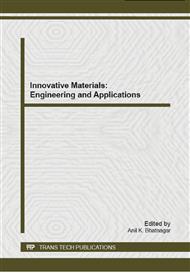p.61
p.65
p.69
p.73
p.79
p.86
p.91
p.97
p.101
Different Carbon Nanotube Content and Dispersant on the Preparation of Fe3O4 / CNTs
Abstract:
This article mainly introduced the preparation and properties of the thermal seed composite. And multiple groups of experiments have been done, which controlled by different content of carbon nanotubes, different surfactants. The results showed that: Fe3O4/CNTs can be made through chemical co-precipitation. Using the same surfactant and under the same experimental conditions, the carbon nanotubes’ surface coating is best and most homogeneous, when the content of the carbon nanotubes is 12.5%. When the content of carbon nanotubes is 12.5% and the experimental conditions are same, choosing CTAB as the surfactant, rather than SDS, finally get the better performance of sample. So the optimal parameters for the experiment are that the content of CNTs is 12.5%, and the choice of surfactant is CTAB. At this time, the surface of carbon nanotubes coats uniformly and the magnetic properties meet the requirements of tumor hyperthermia. In addition, as the carbon nanotubes contain varying degrees of nanocarbon particles, graphite fragments, amorphous carbon and other impurities, Therefore, in this paper, the carbon nanotubes are carbon nanotubes which have been purified with concentrated nitric acid.
Info:
Periodical:
Pages:
79-85
Citation:
Online since:
October 2014
Authors:
Price:
Сopyright:
© 2014 Trans Tech Publications Ltd. All Rights Reserved
Share:
Citation:


